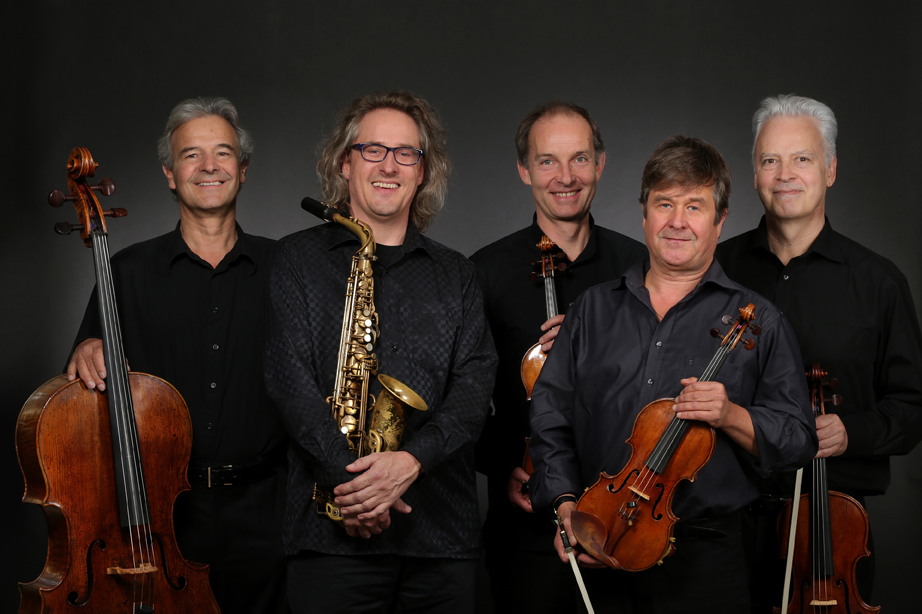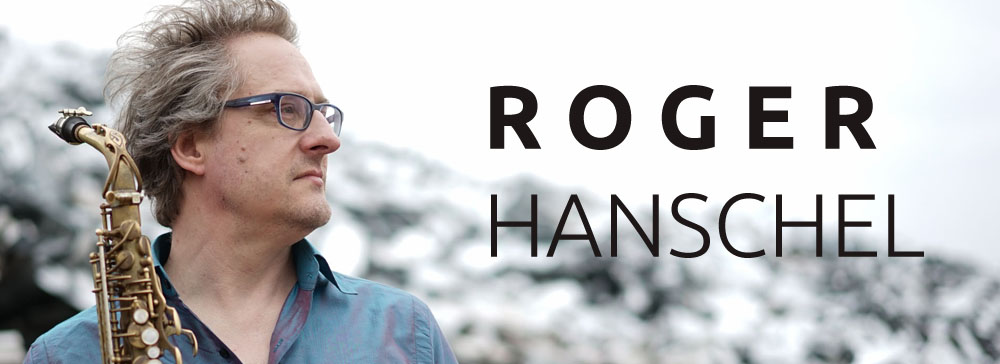
Deutsch
Roger Hanschel & Auryn Quartett
“Niederschlagsmengen” nominated for the “Jahrespreis der deutschen Schallplattenkritik” 2015.
Musik für Saxophon und Streichquartett von Roger Hanschel
Auryn Quartett –
Mathias Lingenfelder
Jens Oppermann
Stewart Eaton
Andreas Arndt
“Years of the fifth period”
Musik für Saxophon und Streichquartett von Roger Hanschel
CD eingespielt:
Frankfurt Contemporary Quartett –
Freya Ritts-Kirby – violin
Jagdish Mistry – violin
Susan Knight – viola
Michael Kasper – cello
The saxophone plays a long, lonely melody. The tones seem to get lost in a vast, empty space, but before that happens, other voices speak up – string instruments. They sink into one’s ears and, through their nervous, slow steadiness, start to excite –
Roger Hanschel approaches classical music from another angle. What may initially appear as constant or slowly changing repetitions of patterns in unusual metres – offering the platform for lyrical excursions, expressive outbursts or virtuoso escapades, often but not always by the saxophone – reveals itself to be a metamorphosis of classical forms of composition in an unaccustomed environment, of themes that wander through the instrumental parts and much more. Indian music emerges, sequences of tones that sound Ottoman, minimal music, jazz in all forms and variations and indeed, “classical music” – but honestly, what does “classical” mean today? A cliché by which each person understands something different. Reason enough, then, to follow the Auryn Quartet’s need to do something different in between. Incidentally, the Auryn Quartet embarks on such excursions from ist ancestral “conventional” world time and time again. Here, they offer the well-known Cologne “Saxophone Mafioso” Roger Hanschel an opportunity to show his mastership in both composition and improvisation. With insatiable curiosity, Roger Hanschel has absorbed the various components of world music and created his very own personal mixture from it. And he is a stupendous virtuoso who knows how to apply new playing techniques – including permanent breathing, for example – in a (not?) breathtaking way.
15 Years after his first Collaboration with the Auryn Quartett Roger Hanschel composed once more a program for saxophone and stringquartet. Roger Hanschel approaches classical music from another angle. What may initially appear as constant or slowly changing repetitions of patterns in unusual metres – offering the platform for lyrical excursions, expressive outbursts or virtuoso escapades, often but not always by the saxophone – reveals itself to be a metamorphosis of classical forms of composition in an unaccustomed environment, of themes that wander through the instrumental parts and much more. Indian music emerges, sequences of tones that sound Ottoman, minimal music, jazz in all forms and variations and indeed, “classical music” – but honestly, what does “classical” mean today? A cliché by which each person understands something different. Reason enough, then, to follow the Auryn Quartet’s need to do something different in between. Incidentally, the Auryn Quartet embarks on such excursions from ist ancestral “conventional” world time and time again. Here, they offer the well-known Cologne “Saxophone Mafioso” Roger Hanschel an opportunity to show his mastership in both composition and improvisation. With insatiable curiosity, Roger Hanschel has absorbed the various components of world music and created his very own personal mixture from it. And he is a stupendous virtuoso who knows how to apply new playing techniques – including permanent breathing, for example – in a (not?) breathtaking way.
“Roger Hanschel’s composition cycle is intelligent chamber music with small improvisational insertions. It integrates various ethnic and historical idioms, as well as enlightened Cologne Jazz, serial and spontaneous music, all in a tight space and with well-considered concise means…. Hanschel composes far from the mainstream and at the height of the times like few others …. Hanschel exemplifies the same intelligent-integrative agility as a performing musician on the saxophone as he does as a composer. Technically he has everything at his disposal what we today call virtuosity and his culture of sound is breathtaking.” Frankfurter Rundschau, 15 January 1998
“The serious rigor of the string quartet, the exemplary genre of classical music, and the improvisational freedom with which Roger Hanschel often raises this saxophone over the foundation of the string movements—both together retain their intrinsic value in the inner courtyard of this historical museum. Until the tones penetrate each other, mix into something new, for which the fashion word ‘cross-over’ is probably too worn out for Hanschel.” Frankfurter Rundschau, 16 August 1999
“Very seldom did he use the strings to deliver supporting sounds in order to have a good romp over them, or as background. No, Hanschel incorporated the quartet into his playing for its varying tonal colors, dense melody weaves and minimalist tonal paintings. One time, though, the woodwind took off in an interlude: a virtually endless monologue which used circular breathing and was loaded with effects, constructive and virtuous. No doubt, Hanschel is a perfectionist.” Kölner Stadt Anzeiger, 16 January 1998
“The music develops magnetic powers and polarizes. Whoever comes under its spell can lose himself in it.” Frankfurter Allgemeine Zeitung, 14, August 1999
“… in his compositions Hanschel combines contemporary classical music and his experiences with jazz and improvised music into expressive and varied tonal images. Most of the time the saxophone stands on an equal basis with the strings and its rich over-tone sound complements and mixes excellently with them. The string movements are very carefully worked out and cleverly use the possibilities of the instruments.” Bonner Rundschau, 14 January 2002
“… music for the head and belly” is what he has composed, says Roger Hanschel. He’s right, since what the exceptional saxophonist has succeeded at doing with this project ‘years of the fifth period’ cannot only be understood as an intellectual pleasure, but also a sensual one….” General-Anzeiger Bonn, 14 January 2002
„What first catches the attention is the lightness with which Hanschel succeeds in melding the sound of his saxophone with the so homogenous sound of the string quartet. In order to reach this, he uses his perfect intonation and a clear and clean sound, often without vibrato.
It is a matter here of a way of playing that is more similar to a classical musician of the French school than to a North American saxophone player. Using an aesthetic that prefers a sound of a sophisticated perfection, Hanschel fits conventional playing techniques into a naturalness that makes one forget how difficult the performance really is“.
Martin Liut, Buenos Aires 2001
-
Recent Posts
Recent Comments
Archives
Categories
Meta

